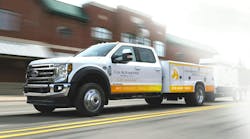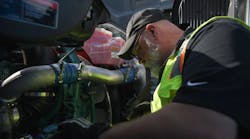Navistar, maker of International brand trucks, introduced its latest initiative to help establish a transparent and unified direction to prioritize customer-centric aftersales support, dubbed Vision 2025. The program establishes a five-year roadmap and common goal among all stakeholders in the organization – including the corporate level, dealer network, and after sales support – to focus on customer needs and service first.
Members of the media were invited to learn more about the initiative during a one-day event in Boulder, Colorado, with representatives from Navistar’s aftersales, parts, and distribution teams, as well as dealers already participating in a strategic focus group established to set the groundwork and promote Vision 2025.
What is Vision 2025, and how did it start?
The Vision 2025 roadmap began with establishing a dedicated aftersales division, according to Friedrich Baumann, president, aftersales, alliance management for Navistar.
"We’ve seen a company that’s gone through a significant change. We now have to change the mindset from survivor mode, to growth, innovation, and long-term perspective,” said Baumann. “We’re going to create this very customer-centric service mentality in our business, and quite frankly, for the industry.”
Baumann has served the commercial vehicle industry for more than two decades and has worked in aftersales support for another OE prior to joining Navistar. In addition to his role leading the aftersales division, Baumann also manages the relationships between Navistar and European stakeholders and partners, Traton, MAN, and Scania brands.
The Navistar team worked with consulting company Root Inc. to provide guidance on developing a vision and roadmap for the company’s future. “In order to really develop this new momentum for our brand and customers, we have to look at our partnership differently,” says Baumann.
Baumann said the company wanted to foster a more collaborative approach, with encouraging more dealer involvement to provide a say in the direction of the company. Eight members of the team – from both the executive and dealer level – formed an advisory committee to create the strategic direction of Vision 2025.
“The committee framework has allowed for more of a collaboration," said Baumann. "What needs to change? What doesn’t work? And, how can we make it a more productive process going forward?”
To share the vision discussed with the strategic committee, an interactive exercise - or “experience” - was created to share with all members of the company. To date, more than 7,500 participants have engaged with the interactive discussion that reviews a visual roadmap representing Navistar’s past, present, and future. Talking points are designed to foster conversation and address the disconnect between the OE and the dealer network, sharing future strategic priorities within the organization focused on putting the customer first.
“The most valuable asset in the entire equation is the customer,” said Terry Minor, president and CEO of Cumberland International Trucks based Middle Tennessee. Minor is also one of the four on the strategic committee for Vision 2025. “When we are at odds with either side, we take the perspective of the customer in order to redirect on the path, to understand what will ultimately benefit the customer.”
Already in motion
Mark Belisle, vice president, distribution, Navistar, provided more details on the committee framework, and how a paradigm shift was needed to change the relationship between the executive team and the dealer network. The collaboration with the Vision 2025 committee extends beyond those committee members, by communicating outcomes from each meeting with the entire dealer network, said Belisle.
In addition to establishing an aftersales division, the company has initiated a number of additional changes to the dealer and customer experience, established greater data transparency, improved parts management, and created a dedicated uptime division.
Improved dealer and customer experiences
In order to improve dealer experience, Belisle said Navistar took a more collaborative approach to involve dealers by listening to dealer concerns, understanding pain points, and delivering an improved experience. One way to improve this process has been to conduct short surveys of dealer network members about once per quarter to gather information on the interactions and experiences with communication between other departments within the company. Those results will then be communicated with the entire dealer network to acknowledge listening and responding to concerns, said Belisle.
On the customer side, Navistar began conducting “mystery shopping” initiatives for both International dealerships and competitors to evaluate customer response time and communication. Information gathered from these surveys has then been shared with the dealership to help make improvements. The organization also aims to provide a consistent, network-wide experience that is standard across all International dealerships.
Another avenue the company has explored has been alternative forms of communication from customers, including website and email inquiries. “Less than 40 percent of the dealers respond within 24 hours to a web inquiry. That’s brand agnostic, across all OEMs,” said Belisle. “Once you understand it, you can do something about it. [The response time goal] should be 100 percent within 24 hours.”
Also expanding on customer experience, the Navistar team confirmed that as of August 1, the Love’s Travel Stops partnership is in full operation, allowing Navistar customers to receive service at any of the 326 Love’s or Speedco locations – increasing the International service network to more than 1,000 locations in the U.S. and Canada. The Love’s and Speedco service centers are designed to handle authorized warranty work with a goal of completing work in three hours or less.
Data transparency
"This is really a paradigm shift,” Belisle said of adopting more transparent data sharing practices. “Historically, the dealer network is pretty protective of their customer data. The world is changing, and in order to be successful going forward, big data and the ability to analyze data and share data – not only between Navistar and the dealers, but the Navistar dealer and customers – will create an unparalleled experience.”
The open architecture of OnCommand Connection, Navistar’s connected vehicle suite of products featuring telematics, ELD, remote diagnostics, and more, will allow dealers the ability to integrate data across a variety of software service platforms, and even with competitive vehicle manufacturers.
“This is big challenge, but [we are] at that phase now where we’ve opened the gates and we’re letting them in,” said Minor. “The only way we achieve the metrics we’re shooting for is to get better data into the system so we can make better decisions for the customer. That means we have the parts in the bay at the right time, with the right technician [to ensure the most optimized service for the customer].”
Parts management
Josef Kory, senior vice president, parts, Navistar, says the company plans to improve parts management through the digitization of the aftersales business – a key to creating predictive parts ordering – along with parts growth through promoting private label brands, and through the expansion of a new e-commerce system to provide transparency with parts inventory monitoring.
Data sharing will drive predictive parts ordering through integration of customer management systems, dealer systems, and suppliers, says Kory. Growing the company’s private label brands Fleetrite and Renew will help appeal to second or third truck owners, and beyond, who may not require a genuine OE replacement part. To do this, Kory confirms the company is exploring avenues to make these parts more readily available by launching non-International branded stores carrying Fleetrite and Renew product lines. Additionally, access to all parts will be made available through an expansion the company’s e-commerce system, RepairLink.
Established uptime team
"We’ve started to build a lot of analytical capabilities and technological improvement in-house to manage total cost of ownership (TCO) better based on the individual requirement of every fleet,” said Chintan Sopariwala, vice president, uptime, Navistar. The Navistar uptime division was formed last year to place focus on vehicle service and TCO.
One such key performance indicator (KPI) was developed to provide an objective view to measure the success of a 24-hour turnaround period for service, by identifying when a vehicle is entering and leaving a dealership location. This is done through geofencing. “It takes the bias out of the system, relying on a technician or human to enter in the information,” Sopariwala said.
Sopariwala confirmed the company has seen a 73 percent improvement in the 24-hour repair turnaround time since tracking and actively communicating this information to dealers in early 2018. One goal from Vision 2025 is to have more than 80 percent of vehicles serviced at a dealership in and out of the service bay and back to the customer within 24 hours.
The Navistar team aims to make these improvements through continued optimization of telematics and over-the-air capabilities to monitor vehicle health, communication with the customer to optimize the service window, and through parts availability with predictive stocking.
One example already in process is the upgrade to the company’s dealer inventory alliance (DIA) retail parts inventory management system. Called DIA 2.0, this system manages inventory for 550 dealer locations and uses a proprietary in-house algorithm to help dealers manage the mix and quantities of parts on the shelf by providing visibility to available parts throughout the dealer network. Having the part on a dealer shelf maximizes the chances of a repair being completed in under 24 hours, said Sopariwala.
Since its launch earlier this year, “we have improved our regional fill rate for safety recalls from 85 percent to 99 percent. For emergency fill rate, we have improved that by 3 percentage points,” said Sopariwala. He advised this program will help to establish a more predictive parts stocking approach for dealers.
What’s next
“Just think about what we have done in the last 18 months as a brand: we’ve gone to dedicated delivery service with the parts distribution center network, we’ve started the journey of lean dealership operations management, we have introduced and fully rolled out DIA 2.0, we have increased the size of our network with our Love’s agreement, we will have the Memphis PDC open by the end of this month, and we’ve successfully implemented predictive stocking,” said Baumann. “I’m absolutely convinced we can be the number-one OEM again with the track record we’ve established over the last 12 to 18 months.”



